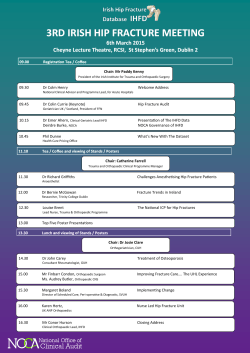
Why do some falls result in fractures? An analysis of over 33,000 institutional falls Prue McRae , Satyan Chari
Why do some falls result in fractures? An analysis of over 33,000 institutional falls Prue McRae†, Satyan Chari‡, Paul Varghese, Kaye Ferrar, Terry Hainesƒ †Safety & Quality Unit, Royal Brisbane and Women’s Hospital, Queensland Falls Injury Prevention Collaborative BACKGROUND RESULTS DISCUSSION Falls among older people in institutional care are an issue of growing concern. While the vast majority of falls do not result in serious harm, injuries such as fallfall-related fractures particular those of the hip, are associated with high mortality and a substantial economic cost3. Our study identified a number of significant (p<=0.05) fallfall-related fracture predictors, and key findings are presented. This study yielded a divergent set of fallfall-related fracture risk factors across hospital and residential care cohorts, highlighting key differences between groups. While many risk factors for falls in hospital and residential care settings have been identified, the risk factors for fallfall-related fractures could differ from the risk factors for falls in general. Therefore, a program with a broad fall prevention focus may not necessarily reduce the rate of fracture and other types of serious injury. A greater understanding of which types of falls are most likely to produce fracture or serious injury would contribute towards increased costcosteffectiveness of programs by allowing for a more targeted approach to falls prevention. AIM The aim of this study was to establish whether specific incidentincident-related characteristics (demographic, spatial, temporal, functional and activity variables) predisposed certain falls to result in fractures. While male hospital patients who fell were almost 3 times less likely to sustain fractures compared to females [OR:0.37 (95% CI: 0.280.28-0.50)], gender remained nonnonsignificant in the residential care cohort. Advance age (over 80) was not linked to fracture risk in residential care. In contrast, the oldest patients in hospital were the ones most likely to fracture upon falling [OR:1.51 (95% CI:1.16CI:1.16-1.96)]. Variables linked to body positions associated with higher impact potential trended towards increased fracture odds across both groups. For example, in hospital, falls while walking [OR:1.96, (95% CI:1.50CI:1.502.56)], falls in corridors [OR:2.39 (95% CI:1.58CI:1.58-3.62)] and falls in bedroom areas other than bedside [OR:1.36 (95% CI:1.00CI:1.00-1.85)] achieved statistical significance. A similar alignment was seen in the residential care data. Hospital patients reported as having been fall risk screened or risk assessed [OR:0.66 (95% CI:0.48CI:0.48-0.92)] were almost half as likely to sustain fractures upon falling. Residential Care Reported falls 24,218 8,980 70.14 (17.28) 80.48(10.65) Median Age 74.35 82.37 Gender % (M:F) 57:43 54:46 229 (0.94) 74 (0.82) Mean Age (SD) Reported fractures (% of reported falls) **each fall represented separately, not clustered by individual in this table. Falls due to trips and falls while walking were associated with increased odds of fractures across both settings suggesting that the identification and management of environmental hazards may contribute towards reducing rates of fracture. REFERENCES 1. Vassallo M, Vignaraja R, Sharma JC, Briggs R, Allen S (2005) The relationship of falls to injury among hospital inin-patients. International Journal of Clinical Practice 59:1759:17-20. Supportive Factors Hospital Our results suggest that hospital injury prevention programs should focus on older female patients and all those aged over 80 due to their higher likelihood to fracture upon falling. This study uncovers important associations between the characteristics of falls and fracture outcomes in institutional settings. These findings further our understanding of the types of institutional falls with the highest fracture potential and may help guide future intervention research. A retrospective cohort design was employed and utilised clinical incident reports completed after falls in public hospital and residential care facilities. Characteristics of incidents included in the dataset are presented in Table 1. Logistic regression analysis was used to examine relationships between a range of predictor variables and fractures Mean (SD) or ratio (%) Additionally, patients reported to be risk assessed or screened at admission appeared less likely to fracture upon falling. It is possible that these patients received fall prevention strategies with a differential minimizing effect on fracture producing falls. CONCLUSIONS METHODS Table 1. Characteristics of fall incidents in study sample** In line with current biomechanical models our findings also indicate that falls from positions with higher impact potentials (eg (eg standing) are most likely to cause fractures. Risk Factors 2. Fonda D, Cook J, Sandler V, Bailey M (2006) Sustained reduction in serious fallfall-related injuries in older people in hospital. Medical Journal of Australia 184:379. 3. Braithwaite RS, Col NF, Wong JB (2003) Estimating Hip Fracture Morbidity, Mortality and Costs. Journal of the American Geriatrics Society 51:364. ACKNOWLEDGEMENTS The authors would like to acknowledge the generous funding support for this project from the Queensland Health Patient Safety Centre. SC would like to thank the RBWH Safety and Quality Unit as well as the Queensland Health Office of Health and Medical Research for supporting this research through resource support and backfill funding respectively. FURTHER INFORMATION ‡ Satyan Chari, Program Coordinator – Falls Risk RBWH/Queensland Health Research Fellow Email: srcha5@student.monash.edu.au Phone: +61 7 3636 5375 ƒ Senior Author
© Copyright 2025





















